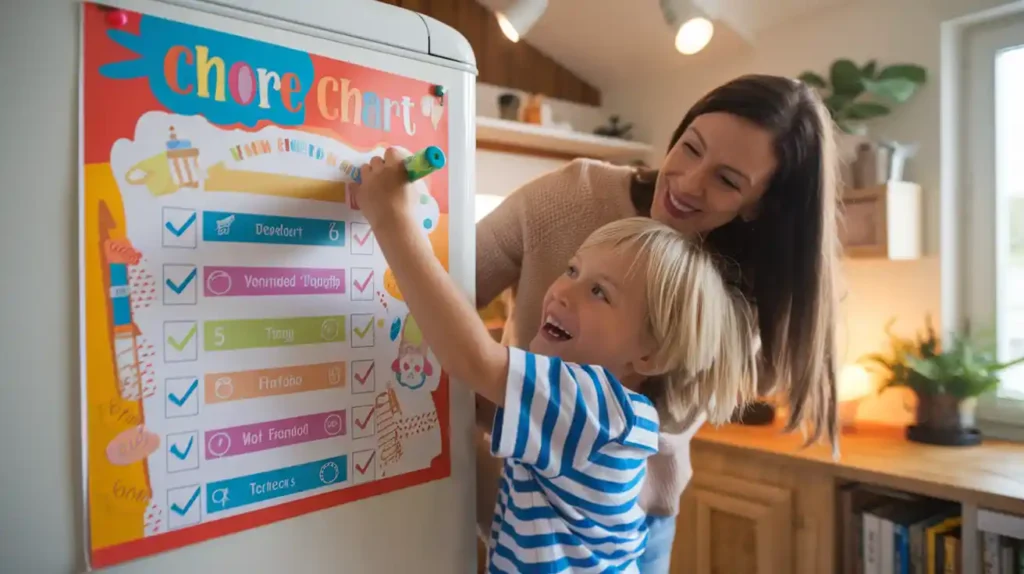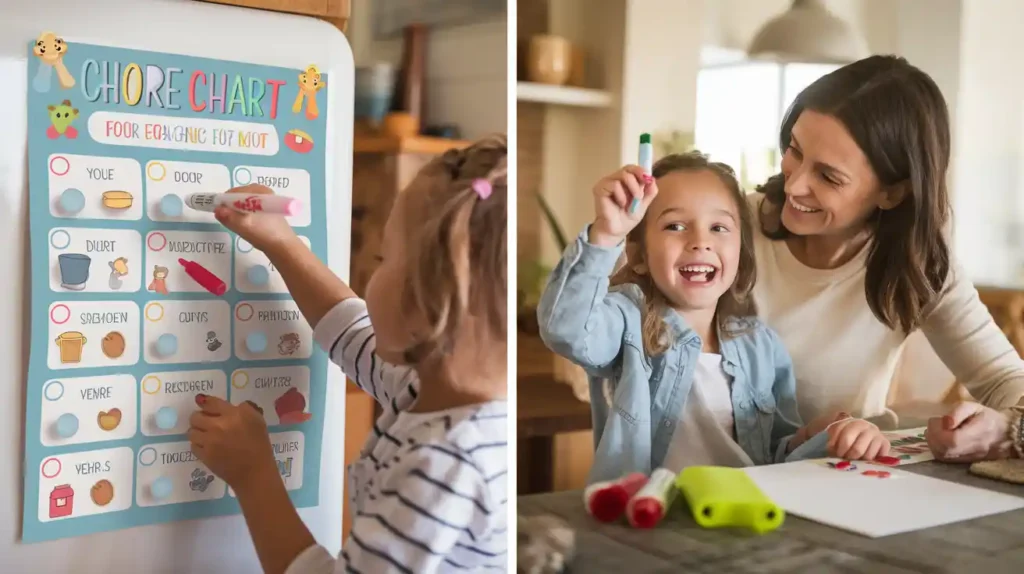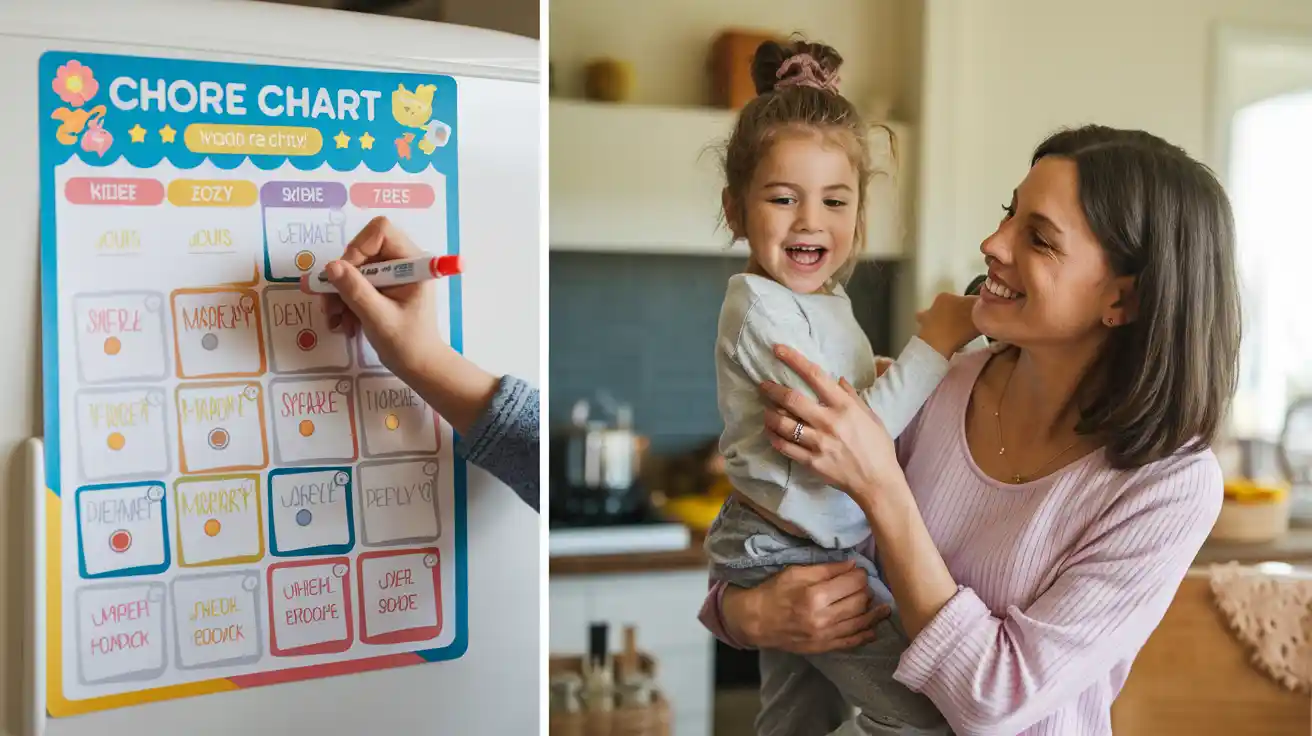Why Chore Charts Are a Game-Changer for Families
I’ll never forget the day I walked into the living room to find toys scattered everywhere, dishes piled in the sink, and my kids arguing over who should clean up. That was the moment I realized we needed a system—a way to teach responsibility while keeping our sanity intact. Enter the chore chart for kids.
At first, I was skeptical. Would my kids actually follow it? Would it just become another thing for me to manage? But to my surprise, the chore chart quickly became one of the best tools in our parenting arsenal. Not only did it help us stay organized, but it also taught my kids valuable life skills like responsibility, teamwork, and time management.
If you’re feeling overwhelmed by the chaos of daily life, a chore chart for kids might be just what your family needs. In this article, I’ll walk you through a step-by-step guide to creating the perfect chore chart that works for your family. Let’s get started!
Table of Contents
Why Chore Charts Are Essential for Kids’ Development
Before we dive into the how-to, let’s talk about why chore charts for kids are so important. Chores aren’t just about keeping the house clean—they’re about teaching kids essential life skills that will serve them well into adulthood.
Research shows that kids who regularly do chores develop a stronger sense of responsibility and self-discipline. According to a study by the University of Minnesota, children who grow up doing chores are more likely to succeed in school, work, and relationships. Chores also help kids feel like valued members of the family, boosting their self-esteem and sense of accomplishment.
For me, the biggest benefit has been the reduction in stress. With a clear system in place, I no longer have to nag my kids to help out around the house. Instead, they know exactly what’s expected of them, and they take pride in completing their tasks.
How to Choose the Right Chores for Your Kids
One of the keys to a successful chore chart for kids is choosing the right tasks. Here’s how I approach it:
Consider Age-Appropriate Tasks
Not all chores are created equal. What works for a teenager won’t necessarily work for a toddler. When assigning chores, I always consider my kids’ ages and abilities. Here are some examples:
- Toddlers (2-3 years): Picking up toys, putting clothes in the hamper, wiping spills.
- Elementary-age kids (4-8 years): Making their bed, setting the table, feeding pets.
- Tweens and teens (9+ years): Doing laundry, washing dishes, vacuuming.
Balance Fun and Responsibility
Let’s face it—some chores are more fun than others. To keep my kids engaged, I try to mix routine tasks with more enjoyable activities. For example, I might pair “clean your room” with “help bake cookies.” This balance keeps things interesting and prevents chore burnout.
Involve Your Kids in the Process
One of the best ways to get kids excited about chores is to involve them in the decision-making process. I’ll often sit down with my kids and ask, “Which chores do you think you can handle?” Giving them a say in the matter increases their motivation and sense of ownership.

Step-by-Step Guide to Creating the Perfect Chore Chart for Kids
Now that we’ve covered the basics, let’s dive into the step-by-step process of creating a chore chart for kids.
Step 1: Define Your Goals
Before you start, it’s important to identify what you want to achieve with your chore chart. Are you trying to teach responsibility? Reduce household stress? Or simply get your kids to help out more? For me, the goal was to create a system that was fair, easy to follow, and effective.
Step 2: Choose a Format
There are countless ways to create a chore chart for kids, and the right format depends on your family’s needs. Here are a few options I’ve tried:
- Printable Charts: Simple and customizable, perfect for younger kids.
- Whiteboards: Great for families who like to update chores frequently.
- Apps: Ideal for tech-savvy families who want reminders and rewards built in.
I personally love using a whiteboard because it’s easy to update and visually appealing. Plus, my kids enjoy checking off their tasks with colorful markers.
Step 3: Assign Chores
Once you’ve chosen a format, it’s time to assign chores. I recommend starting small and gradually adding more tasks as your kids get the hang of it. Here’s how I do it:
- Make a List: Write down all the chores that need to be done.
- Assign Tasks: Match each chore to the appropriate child based on age and ability.
- Rotate Chores: To prevent boredom, I rotate chores every week or month.
Step 4: Set Clear Expectations
One of the biggest mistakes I made early on was not being specific enough. Saying “clean your room” is too vague—what does that actually mean? Instead, I now provide clear instructions like “put all toys in the bin, make your bed, and vacuum the floor.” This eliminates confusion and ensures everyone is on the same page.
Step 5: Create a Reward System
Let’s be honest—kids need motivation. That’s why I always include a reward system in our chore chart for kids. Here are some ideas:
- Stickers or Stars: Younger kids love earning stickers for each completed chore.
- Screen Time: Offer extra screen time as a reward for finishing all tasks.
- Family Outings: Plan a special outing, like a trip to the park or ice cream shop, as a reward for consistent effort.
Step 6: Implement and Adjust
The final step is to put your chore chart into action. Be prepared for some trial and error—it might take a few weeks to find a system that works for your family. If something isn’t working, don’t be afraid to make adjustments. For example, if a chore is too difficult, simplify it. If a reward isn’t motivating, try something new.
Tips for Making Chore Charts Fun and Effective
Creating a chore chart for kids is just the beginning. Here are some tips I’ve learned to keep things fun and effective:
Use Visuals and Colors
Kids are visual learners, so I always make our chore chart colorful and engaging. I’ll use stickers, drawings, or even photos of my kids completing their tasks. This makes the chart more appealing and helps younger kids understand what’s expected.
Turn Chores into a Game
Who says chores have to be boring? I like to turn them into a game or challenge. For example, I’ll set a timer and see who can clean up their toys the fastest. Or I’ll create a “chore bingo” chart with prizes for completing a row of tasks.
Celebrate Successes
Finally, don’t forget to celebrate your kids’ achievements. Whether it’s a high-five, a sticker, or a special treat, acknowledging their hard work goes a long way in keeping them motivated.

Common Mistakes to Avoid When Creating a Chore Chart
Even with the best intentions, it’s easy to make mistakes when creating a chore chart for kids. Here are some pitfalls to watch out for:
Overloading Kids with Too Many Chores
It’s tempting to assign a long list of tasks, but this can quickly lead to burnout. Start small and gradually add more chores as your kids get comfortable.
Being Inconsistent
Consistency is key when it comes to chore charts. If you only enforce the chart occasionally, your kids won’t take it seriously. Stick to the system, even when it’s challenging.
Neglecting to Model Good Behavior
Kids learn by example, so it’s important to model good behavior. If I want my kids to keep their rooms clean, I make sure to keep my own space tidy too.
Conclusion: Empower Your Kids with a Chore Chart
Creating a chore chart for kids has been one of the best decisions I’ve made as a parent. Not only has it helped us stay organized, but it’s also taught my kids valuable life skills and brought us closer as a family.
If you’re ready to give it a try, start small, stay consistent, and celebrate your kids’ progress along the way. And don’t forget to share your favorite tips for creating a chore chart in the comments below—I’d love to hear what works for your family!
FAQs About Chore Charts for Kids
What age should kids start using a chore chart?
Kids as young as 2-3 years old can start with simple tasks like picking up toys or putting clothes in the hamper.
How do I motivate my kids to do their chores?
Try using rewards, praise, and involving them in the process. Stickers, extra screen time, or a special outing can work wonders.
Should I pay my kids for doing chores?
It depends on your family’s values. Some parents prefer non-monetary rewards, while others use an allowance system.
What if my child refuses to do their chores?
Set clear consequences and stay consistent. For example, no screen time until chores are done.
How often should I update the chore chart?
Review and update the chart weekly or monthly to keep it fresh and relevant.

